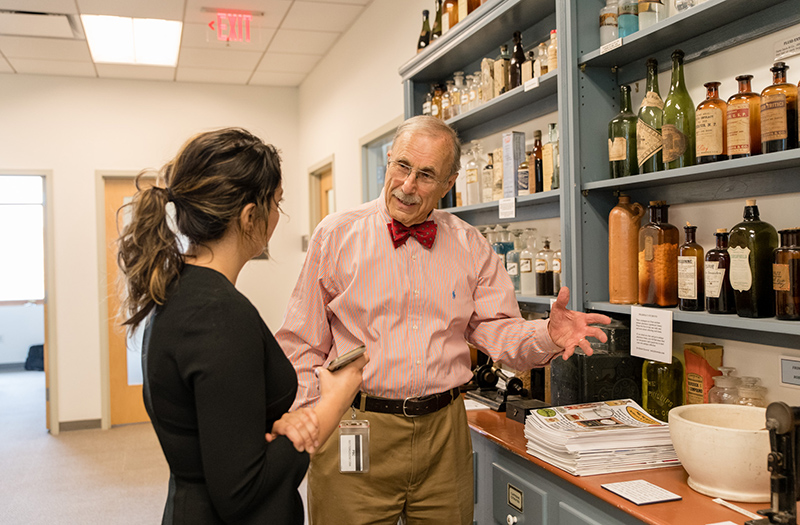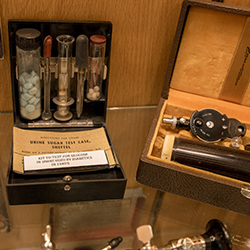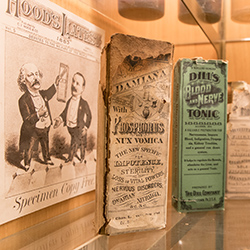
UA College of Medicine – Phoenix Uses the History of Medicine to Teach Future Physicians

While medicine has evolved immensely over the years, a University of Arizona College of Medicine – Phoenix faculty member believes that looking back to old treatments and tools of the trade provide important lessons for future physicians.
The college is home to more than 300 medical antiques curated and owned by Robert Kravetz, MD, a gastroenterologist and clinical professor of Internal Medicine and Medical Humanism.

His personal favorites are a Revolutionary War-era drug chest and a leech jar from the late 1800s.
Among the displays shown in cases throughout the Phoenix Biomedical Campus are tools that allowed doctors to manually count red blood cells, amputation saws, forceps, tonsil dissectors, retractors and sigmoidoscopies.
Some of the pharmaceuticals displayed are still used today, such as nitroglycerin and digitalis — both still treat some heart problems. Many diagnostic devices have advanced over the years, but are used for the same purpose — such as otoscopes to look into the ear, stethoscopes to listen to the heart or lungs, nebulizers for breathing treatments and blood pressure monitors.
Inside the cases are some items that seem counterintuitive to modern medical standards and border on quackery: cigarettes that claim to ease asthma, devices for bloodletting and a violet ray machine used in the 1930s that emitted a purple light and was run over the body.
“Totally worthless,” said Dr. Kravetz of the violet ray machine. “We have so many medicines today, but years ago, there was very little available. That’s why people would use these various products. When there isn’t a beneficial therapy for something, people will try anything.”
Although seemingly unimportant to current medical practice, Dr. Kravetz believes the antiquated devices are an important reminder to today’s physicians in training.
“We have to realize that where we are today is because of all those who have preceded us,” he said. “We have to pay homage to them and give them credit. We also can learn from the medical mistakes of the past, as there have been some drastic things done that have not been beneficial to patients.”

The curriculum is based on learning about a medical topic related to the residency program the student plans to pursue.
“I give them free rein to choose whatever topic they wish and try to instill in them the importance of the history of medicine,” he said. “If you don’t know about the past, you don’t know where you are going in the future.”
Dr. Kravetz hopes the gifts from his personal collection will be the beginning of students’ own collections.
He tells the future physicians that “as you go through your four years in medical school, look at the antiques on campus and see how they relate to what you are learning at the present time.”
Topics
About the College
Founded in 2007, the University of Arizona College of Medicine – Phoenix inspires and trains exemplary physicians, scientists and leaders to advance its core missions in education, research, clinical care and service to communities across Arizona. The college’s strength lies in our collaborations and partnerships with clinical affiliates, community organizations and industry sponsors. With our primary affiliate, Banner Health, we are recognized as the premier academic medical center in Phoenix. As an anchor institution of the Phoenix Bioscience Core, the college is home to signature research programs in neurosciences, cardiopulmonary diseases, immunology, informatics and metabolism. These focus areas uniquely position us to drive biomedical research and bolster economic development in the region.
As an urban institution with strong roots in rural and tribal health, the college has graduated more than 1,000 physicians and matriculates 130 students each year. Greater than 60% of matriculating students are from Arizona and many continue training at our GME sponsored residency programs, ultimately pursuing local academic and community-based opportunities. While our traditional four-year program continues to thrive, we will launch our recently approved accelerated three-year medical student curriculum with exclusive focus on primary care. This program is designed to further enhance workforce retention needs across Arizona.
The college has embarked on our strategic plan for 2025 to 2030. Learn more.